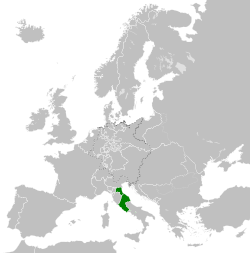Papal States
| ||||||||||||||||||||||||||||||||||||||||||||||||||||||||||||||||||||||||||
The Papal States, officially the State of the Church (Italian: Stato della Chiesa, Italian pronunciation: [ˈstato della ˈkjɛːza]; Latin: Status Ecclesiasticus;[2] also Dicio Pontificia), were a series of territories in the Italian Peninsula under the direct sovereign rule of the Pope, from the 8th century until 1870.
By 1861, much of the Papal States' territory had been conquered by the Kingdom of Italy. In 1870, the Pope lost Lazio and Rome and had no physical territory at all, except the Vatican.
Related pages[change | change source]
References[change | change source]
- ↑ Statistica della popolazione dello Stato pontificio dell'anno 1853 (PDF). Ministero del commercio e lavori pubblici. 1857. p. XXII. Archived from the original (PDF) on 2 March 2018. Retrieved 1 March 2018.
- ↑ Frederik de Wit, "Status Ecclesiasticus et Magnus Ducatus Thoscanae" (1700)




